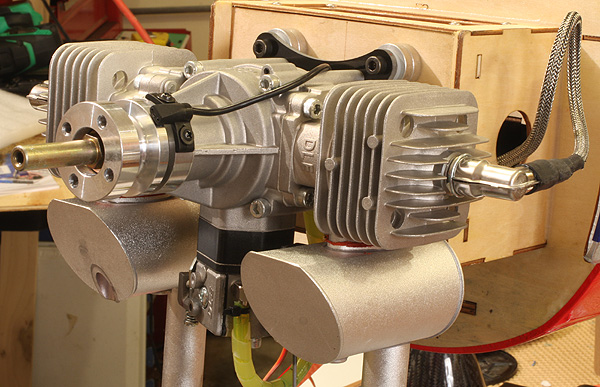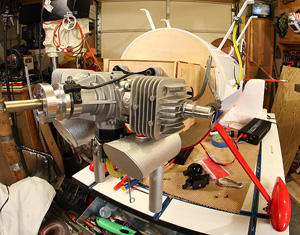



My second twin-cylinder engine and I was not disappointed. Smooth-running
lots of power and very reliable.
Text, photos and video by Tom Hintz
Flight video by Clark Ponthier
Posted – 11-26-2014
When I decided to build an Aeroworks 50cc Pitts Python ARF-QB the only power source that came to mind was the DLE-60 Twin Engine. I already have the DLE 40-Twin and DLE-61 in my other gas planes and there has been absolutely nothing in their performance to make me want to look elsewhere. DLE engines are also some of the most budget friendly engines on the market and as long as I have to pay for my flying hobby, cost remains an important consideration.
The DLE-60 Twin Engine (#DLEG0060) actually has a displacement of 61 cc (3.7 cu in) produced by a 1.42-inch (36 mm) bore and a 1.18-inch (30 mm) stroke. It has a compression ratio of 7.6:1 and runs on a (unleaded) gas/oil mix of 30:1. The engine itself weighs just 54.85-oz (1555 g), the mufflers (2) 2.82-oz (80 g) and 3.0-oz (85 g). The included ignition module weighs 7.44-oz (211 g) including the twin shielded plug wires. That’s a total weight of just 4.4-lb (2.0 kg) for an engine package that puts out 5.5-hp @ 8,500-rpm with a working rpm range of 1,400 to 8,500rpm!
I should note that the included mufflers are called “Pitts style” and do terminate in a pair of down tubes through the cowl that have the traditional Pitts look. The front of the cans or muffler bodies is angled to provide more clearance for rounded and close-fitting cowls. In my Aeroworks 50cc Pitts Python ARF-QB the stock mufflers worked fine and the down tubes are long enough that I did not have to add extensions.
There are rumors that DLE spark plugs suck and the only set I have run in an engine died in short order. I can’t say that supports the rumor but DLE recommends the NGK CM6 plug for the DLE-60 Twin Engine and that is exactly what I run in all of my DLE engines. That same NGK CM6 plug is in all of the other DLE engines I have seen at our field and others. You decide on your own.
DLE supplies the engine itself, ignition module, mufflers, 2 NGK CM6 spark plugs and stand offs. You have to come up with an ignition battery (4.8V-12V) unleaded gasoline, oil (for gas mix) and propellers. DLE recommends props such as 22X10, 23X8, 23X10, 24X8. I have been using Vess 23B and 24B props and the DLE-60 Twin Engine in the Aeroworks 50cc Pitts Python ARF-QB it’s in seem to like them.

This engine fit my Pitts cowl with only
the spark plugs hanging out.
Installing the DLE-60 Twin Engine is as easy as it gets. The mount is already secured to the back of the motor and the mounting bolt pattern often matches templates/patterns for other popular engines. I have yet to install a DLE engine on an Aeroworks plane that did not match one of the included templates packed with the plane. If all else fails you can download and print a paper mounting template from the DLE site that includes alignment lines that make perfect alignment simple.
One thing to be sure and check is the mounted length. Most airplanes have a critical dimension from the front of the firewall to the motor surface against which the prop mounts. This is to be sure that the prop or spinner back plate clears the front of the cowl. I had to use the supplied washers that came with the Aeroworks 50cc Pitts Python ARF-QB kit rather than the machined aluminum standoffs that came with the DLE-60 Twin Engine. Either way, hitting this dimension has been easy with every DLE engine I fly.
The carb arm to which the servo connects is reposition-able so that you can always have the servo pulling the carb open rather than pushing on it. That way if there is a failure in the linkage the carburetor snaps closed rather than hanging wide open. I always put a drop of blue (removable) thread locker on this screw.
I start gas engines for the first time on the plane but before the cowl is permanently installed. Getting gas from the new tank to the new motor can be frustrating when you can’t physically touch the carb. To save a bunch of flipping I temporarily put a piece of tape over the carb air inlet to seal it. With the ignition off turn the prop through a couple turns while watching the fuel line. The vacuum from the cylinders sucks gas to the carb, usually by the third turn of the prop. That gets gas to the pumper carb on DLE engines. Take the tape off, engage the choke, turn the ignition on and flip the prop until it “pops” or runs a second or two before dying. Open the choke and flip the motor to start it. Once the DLE-60 Twin Engine had gas to the carb I never had trouble starting it. Even after letting the plane sit for a week, several flips with the choke on produced the “pops” that signals a prime. After that the DLE-60 Twin Engine generally starts on the third or fourth flip. The rest of that day will often see the DLE-60 Twin Engine start without choking.
After running the motor through a couple tanks of gas in the yard I install the cowl and run the engine again to be sure it has not richened up too much. I know this is extra work but it usually saves a lot of time when you don’t have to take the cowl off again. Many times adding the cowl will richen the mixture in flight and require another small carb adjustment.
The first few flights for the DLE-60 Twin Engine in my Aeroworks 50cc Pitts Python ARF-QB were devoted to lots of touch and go’s to keep the engine cooler and lots of fuel going through it for lubrication. From there I gradually increased the power usage to see how the DLE-60 Twin Engine pulls. Apparently a 17-1/2-lb plane bolted to the back of the DLE-60 Twin Engine doesn’t concern it much. I am currently flying it with the Vess 24B prop and DLE-60 Twin Engine pulls very well anywhere I point it. It’s not just straight up and disappear kind of power but open the throttle and it punches out of a blown hover with complete control surface authority.
Even though the DLE-60 Twin Engine has plenty of power and is probably running richer than need be initially the fuel usage seems remarkably low. I have a 32-ounce tank in the Pitts and after a 10 minute flight the tank still looks to be ¾ full. When Fortitude starts making a 24 or 26-ounce tank I might replace the 32-ounce just to “build in a little more light” (a catchy but all too true quote from a pilot friend of mine) into the Pitts because having enough fuel on board for a 10 minute flight does not seem to be an issue with the DLE-60 Twin Engine.
The DLE-60 Twin Engine has proven to be everything I wanted and more. It has all of the power I need, sounds great, starts easily and runs dependably. Though I have dozens of flights on a brand new motor I have not had a dead stick yet. And the twin cylinders looks very cool and have a sound that gets people’s attention.
The included mufflers do sound great but more importantly they it the round cowl nicely the longer than usual down tubes dump the exhaust far enough from the cowl openings that extra extensions can be left on the ground. I like it when stock mufflers don’t conflict with other parts of the plane!
I’ve not had my DLE-60 Twin Engine very long but there are plenty of DLE engines at the flying fields I go to so I am confident in their durability. Plus, current DLE engine owners are very interested in the DLE-60 Twin Engine which is testament to their satisfaction with the brand.
All this makes the street price of $549.00 (10-27-2014) for the DLE-60 Twin Engine even more attractive. Saving some money on a good engine like the DLE-60 Twin Engine lets us spend a little more on the planes we put it in. I like that kind of economics.
Visit the DLE-60 Twin Engine web page – Click Here
Have a comment on this review? –Email Me!